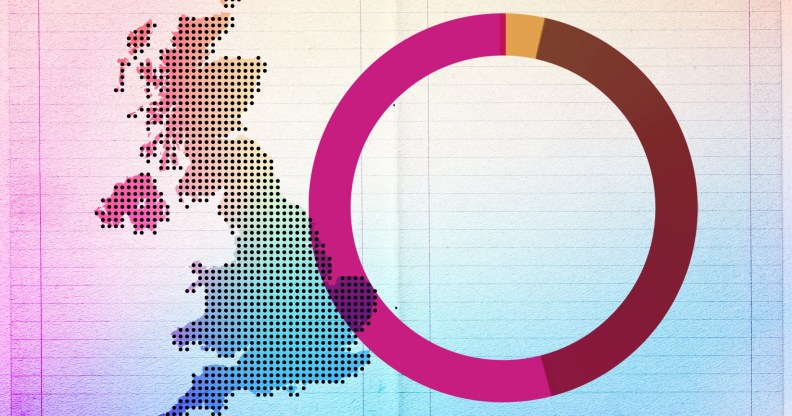Groundbreaking new census data reveals Gen Z twice as likely to identify as queer

Gen Z are most likely to be LGB+ according to new ONS data. (Getty)
Gen Z are most likely to be LGB+ according to new ONS data. (Getty)
New data from the census 2021 confirms that more and more young people feel safe enough to come out as LGBTQ+.
Having released census data which captured the size of England and Wales’ LGBTQ+ population for the first time, the Office for National Statistics (ONS) has now shared a breakdown of the community by age and sex.
The statistics, published Wednesday (25 January), found that the 16-24 age group had the highest proportion of lesbian, gay and bisexual people.
Of the group, 6.91 per cent, 436,000, said they were lesbian gay or bi (the data did not consider gender identity).
This is more than twice the percentage (3.16 per cent) of the overall population.
Within the age bracket, four per cent identified as bisexual (252,000 people).
The new census data also reveals there are more queer women than men – 3.32 per cent of women (830,000) said they were LGB+ compared with 3 per cent of men (706,000).
Women were twice as likely as men to identify as bisexual (1.76 per cent vs 0.78 per cent), while men were more likely to identify as gay (1.95 per cent vs 1.15 er cent).
More males in England (3.02 per cent) identified as LGB+ than in Wales (2.65 per cent). Among women the percentages were almost identical – 3.32 per cent in England and 3.33 per cent in Wales.
The census data confirms that young people feel more comfortable identifying as queer, and that they are more likely to fall somewhere in the middle of the Kinsey scale.
Raquel, 21, is a bisexual cis woman and an ambassador for the LGBTQ+ young people’s charity Just Like Us.
She told PinkNews: “I think I feel so comfortable calling myself bisexual because we are all more informed and educated nowadays about different sexual orientations, so when I began to understand myself and who I am attracted to, it was very obvious to me that I was indeed bisexual.”
“Although I was not surprised to see that the younger populations identify more with LGBT+ labels, as there is less stigma and knowledge in the area, I think it should be equal throughout all age groups. I think the reason that older age groups do not identify as LGBT+ is because of a lack of education and negative stereotypes that unfortunately are difficult to unlearn. It is sad to think that there may be a lot of adults over 24 that may be LGBT+ but they don’t know or are too scared to come out.”
New census data is ‘a wake up call’ to politicians
LGBTQ+ charity Stonewall described the new cenus data as a “wake up call” to politicians, saying that the “Rainbow Generation” is the future.
“This data will allow national and local government to tailor their services, for example, we know that LGBTQ+ people can face discrimination in care settings – this will help in commissioning of care for older LGBTQ+ people,” Stonewall said.
“Soon these generations will be the biggest section of our workforce, the people who will be consuming our media, the talent pipeline for our sports, the audience for our cultural output, the people we want to nurture as our future voters.”
Nancy Kelley, chief executive of the charity, described the new data as another “historic” step forward after centuries of LGBTQ+ invisibility.
“This data is a reminder that our leaders, institutions and governments need to step up efforts to truly champion our communities rather than using our lives in a ‘culture war’ that does not resonate with the experiences and values of voters,” she added.
Dominic Arnall, chief executive of Just Like Us, said: “Sadly, we know that young LGBT+ people face disproportionate challenges, including being twice as likely to face bullying as their straight peers.
“The census data makes it clearer than ever that issues of bullying must be tackled and that inclusive education should be the norm across the UK, so that the increasing number of openly LGBT+ young people can thrive in schools which are happy, welcoming and safe environments.”
In January, census data revealed the size of the LGBTQ+ population in England and Wales for the first time.
Around 1.5 million people (3.2 per cent) identified themselves as LGB+, while 43.4 million people (89.4 per cent) identified as straight or heterosexual.
A total of 748,000 described themselves as gay or lesbian, 624,000 described themselves as bisexual, and 165,000 selected “other sexual orientation”.
More than 260,000 people identified themselves as trans.

